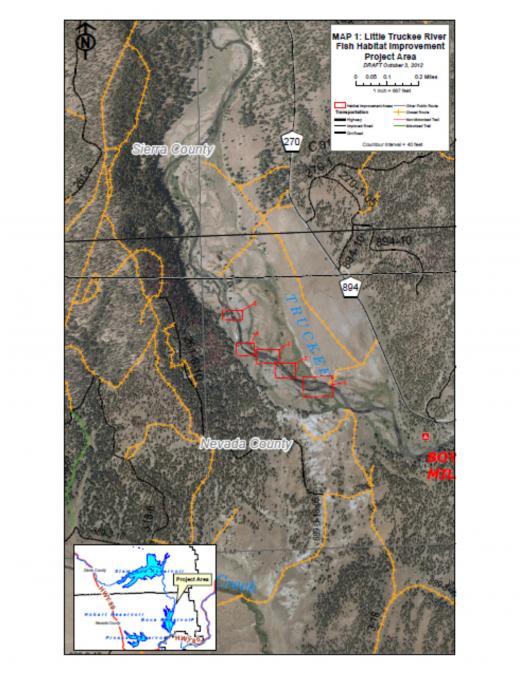Improving an Iconic Wild Trout Water
This part of the Little Truckee River is a favorite for anglers all over California, especially, Nevada and Placer Counties. From previous field surveys, California Department of Fish and Game and Forest Service Biologists identified the lower Little Truckee River meadow as a high priority for supplemental instream structure and large woody debris, to increase cover and rearing habitat for trout. Large woody debris, which was historically present through natural recruitment, is absent from this reach of the Little Truckee because of Stampede Reservoir, located just upstream. Wild trout thrive where this structure currently exists in the system, and conversely, where it is absent fish numbers are low or non-existent. Anecdotal evidence from anglers demonstrates that fish populations through the lower extent of the Little Truckee meadow are substantially reduced from populations occupying the upstream habitat because of the lack of large woody debris instream. This is additionally evident by the amount of anglers that use the upper parking lot to access the river, which is exponentially greater than the pressure observed in the lower meadow access points. Further more, fish creel data from CDFG shows that catch-per-hour significantly decreases in this section of the river.
Little Truckee Site Explanations
Area 1: Secondary and main channel confluence
Primary goal: Adult in-stream habitat
This site largely lacks cover and the thalweg (deepest habitat) is limited to a narrow area.
In-stream wood structures and boulders will be introduced to encourage scour while mature willow transplants provide cover and bank erosion protection
Scour holes will be pre-excavated by large equipment to remove an armoring layer and facilitate natural scour under higher flows.
Area 2: Backwater site
Primary goal: Juvenile and adult habitat
This site already provides a low-velocity backwater environment over a range of flows. Main channel exhibits deep channel with little cover.
The backwater will be excavated to provide larger area for juveniles and wood will be introduced to provide some cover.
Wood along the left bank will also provide scour and cover in the main channel. Boulders are also introduced to the main channel
Area 3: Steep Riffle Site
Primary goal: Adult habitat/passage
This site currently offers little complexity and fast water
In-stream wood will be introduced to both banks to encourage hydraulics, scour and provide differing velocity environments.
Scour holes will be pre-excavated by large equipment to remove an armoring layer and facilitate natural scour under higher flows.
Transplanted willows will be placed in areas susceptible to bank scour erosion (to provide erosion protection and additional cover).
Area 4: Backwater site
Primary goal: Juvenile and adult habitat
This site provides backwater under a moderate range of flows and a deep thalweg along an outside bend of the main channel, but lacks cover
The backwater will be excavated to provide additional usable habitat. Wood will be used to create grade-control at the backwater entrance (to avoid capture of main channel)
Wood will also be introduced to the inlet and deepest areas of the backwater to provide cover.
The main channel (right bank) will be modified to include a number of habitat structures and bank erosion control (i.e., grading and transplanted willows). Wood will be placed such that
they influence hydraulics over a range of flows.
Area 5: River bend
Primary goal: Adult habitat
This site is similar to Area 4 such that it is characterized by a deep thalweg along an outside bend, but lacks cover.
The main channel (right bank) will be modified to include a number of habitat structures and bank erosion control (i.e., grading and transplanted willows). Wood will be placed such that they influence hydraulics over a range of flows.


